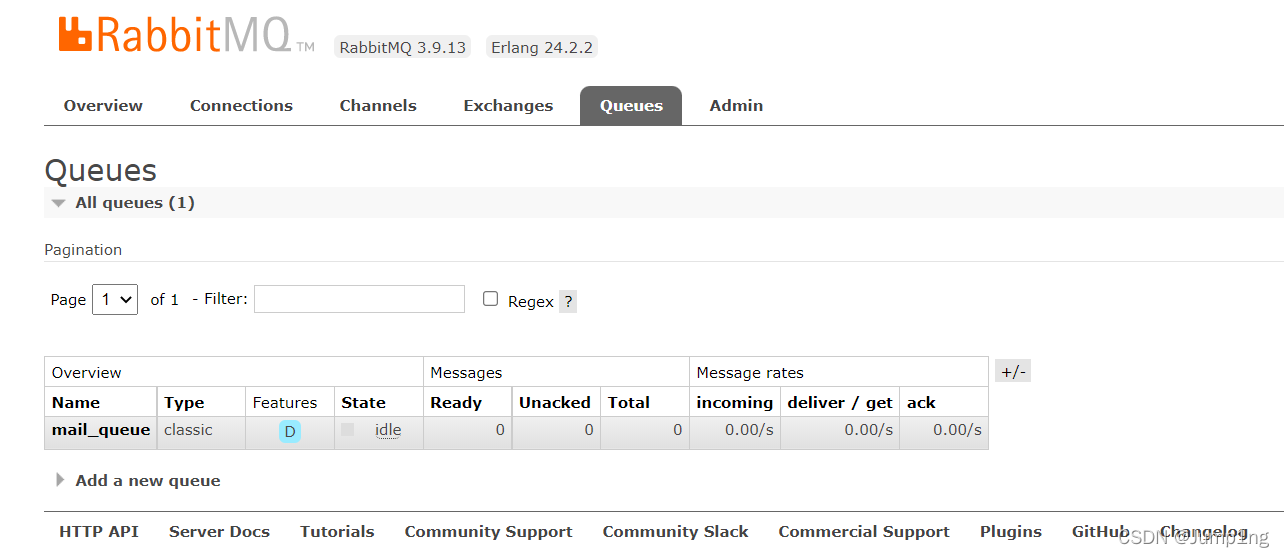本博客讲述的是RabbitMQ基于AMQP协议的消息中间件,在互联网应用的开发中,RabbitMQ是确保消息发送和消费成功,设置消息有效期和延迟队列的一个重要的中间件。它的特点具有安全性、可用性、集群、多协议支持、可视化客户端等等。
关于他的详细介绍和作用就不一一赘述了,下面引用一个邮件发送的案例来加深理解。
搭建一个简单的邮件发送服务,需要用到的开发工具有IntelliJ IDEA,RabbitMQ、MySQL,Postman用来作为测试接口。
案例介绍:假如现在某公司新招聘了一批员工,需要给新员工发送入职欢迎邮件,我们要保证在邮件发送成功的基础上,不重复发送邮件,且需要监听邮件发送的进程。
案例分析:这是一个简单的邮件发送服务,需要用到消息中间件来监听消息队列,确保消息发送和消费的可靠性,并且要考虑到幂等性的问题?。
首先,我们开始搭建简单的邮件发送服务器。
小编用的是聚合工程,在旧项目中进行改进,下来小伙伴可以在一个工程中完成操作,原理相同。
一、项目基础搭建
1.1添加依赖
web、websocket、amqp、mysql-connector、mybatis、redis、mail
1.2application.properties
为贴近真实项目,这边的application.properties配置文件用到两个不同的server.port端口
配置文件如下:
spring.datasource.username=root
spring.datasource.password=root
spring.datasource.url=jdbc:mysql:///vhr?serverTimezone=Asia/Shanghai
server.port=8081
spring.rabbitmq.virtual-host=/
spring.rabbitmq.username=guest
spring.rabbitmq.password=guest
spring.rabbitmq.host=192.168.64.128
spring.rabbitmq.port=5672
spring.rabbitmq.publisher-confirm-type=correlated
spring.rabbitmq.publisher-returns=true?这是我们项目的properties配置。
spring.rabbitmq.virtual-host=/
spring.rabbitmq.username=guest
spring.rabbitmq.password=guest
spring.rabbitmq.host=192.168.64.128
spring.rabbitmq.port=5672?这是邮件发送服务的properties配置。(默认server.port端口为8080)
二、搭建邮件服务
为了方便测试,添加新员工返回一段JSON
controller:
@RestController
@RequestMapping("/employee/basic")
public class EmployeeController {
@Autowired
EmployeeService employeeService;
/**
* 使用 JSON 格式传递参数
* @param employee @RequestBody
* @return
*/
@PostMapping("/addEmps")
public RespBean addEmps(@RequestBody Employee employee){
employeeService.addEmps(employee);
return RespBean.ok("添加成功");
}
}当在springboot项目中登录成功后,post请求访问/employee/basic/addEmps时传递JSON格式的参数,即可完成数据添加。
实体类:
?employee表实体类:
?该表为插入员工的员工表,这里为了简化测试,只添加了两个字段。
public class Employee implements Serializable {
private Integer id;
private String name;
private String email;
public Integer getId() {
return id;
}
public void setId(Integer id) {
this.id = id;
}
public String getName() {
return name;
}
public void setName(String name) {
this.name = name;
}
public String getEmail() {
return email;
}
public void setEmail(String email) {
this.email = email;
}
}mail_send_log表实体类:
该表为邮件发送的日志表,记录了消息的id、员工id、状态(0为发送中,1为发送成功,2为发送失败)、队列、交换机、重试次数、重试时间、创建及更新时间。
public class MailSendLog {
//消息的 id,即 correlationId
private String msgId;
//添加成功的员工id
private Integer empId;
private Integer status;
private String routeKey;
private String exchange;
private Integer count;
private Date tryTime;
private Date createTime;
private Date updateTime;
public String getMsgId() {
return msgId;
}
public void setMsgId(String msgId) {
this.msgId = msgId;
}
public Integer getEmpId() {
return empId;
}
public void setEmpId(Integer empId) {
this.empId = empId;
}
public Integer getStatus() {
return status;
}
public void setStatus(Integer status) {
this.status = status;
}
public String getRouteKey() {
return routeKey;
}
public void setRouteKey(String routeKey) {
this.routeKey = routeKey;
}
public String getExchange() {
return exchange;
}
public void setExchange(String exchange) {
this.exchange = exchange;
}
public Integer getCount() {
return count;
}
public void setCount(Integer count) {
this.count = count;
}
public Date getTryTime() {
return tryTime;
}
public void setTryTime(Date tryTime) {
this.tryTime = tryTime;
}
public Date getCreateTime() {
return createTime;
}
public void setCreateTime(Date createTime) {
this.createTime = createTime;
}
public Date getUpdateTime() {
return updateTime;
}
public void setUpdateTime(Date updateTime) {
this.updateTime = updateTime;
}
}Mail实体类:
邮件的实体类,简单编辑两个字段,邮件内容和邮件发送给谁。
public class Mail implements Serializable {
private String mailContent;
private String to;
public String getMailContent() {
return mailContent;
}
public void setMailContent(String mailContent) {
this.mailContent = mailContent;
}
public String getTo() {
return to;
}
public void setTo(String to) {
this.to = to;
}
}service层:
?EmployeeService
@Service
public class EmployeeService {
@Autowired
EmployeeMapper employeeMapper;
@Autowired
RabbitTemplate rabbitTemplate;
@Autowired
MailSendLogService mailSendLogService;
/**
* 1.将用户数据添加到数据库中
* 2.数据添加完成后,给新员工发送一封欢迎邮件
* 3.向 mail_send_log 表中添加一条发送日志的记录
* @param employee
*/
@Transactional
public void addEmps(Employee employee) {
//由于需要用到主键回填,因此需要开启事务
employeeMapper.addEmps(employee);
Mail mail = new Mail();
mail.setMailContent("入职欢迎邮件");
mail.setTo(employee.getEmail());
String correlationId = UUID.randomUUID().toString();
rabbitTemplate.convertAndSend(RabbitConfig.MAIL_EXCHANGE,RabbitConfig.MAIL_QUEUE,mail,new CorrelationData(correlationId));
MailSendLog mailSendLog = new MailSendLog();
//重试次数 第一次添加,该值为0
mailSendLog.setCount(0);
mailSendLog.setCreateTime(new Date());
mailSendLog.setUpdateTime(new Date());
//该id为刚刚设置主键回填的id,从员工表中获取
mailSendLog.setEmpId(employee.getId());
mailSendLog.setExchange(RabbitConfig.MAIL_EXCHANGE);
mailSendLog.setMsgId(correlationId);
mailSendLog.setRouteKey(RabbitConfig.MAIL_QUEUE);
//0表示消息处于发送中
mailSendLog.setStatus(0);
//重试时间是一分钟之后,一分钟之后如果这条记录的状态还是0,则重试
mailSendLog.setTryTime(new Date(System.currentTimeMillis()+60*1000));
mailSendLogService.addLog(mailSendLog);
}
/**
* 根据id查询刚刚添加的日志
* @param empId
* @return
*/
public Employee getEmpById(Integer empId) {
return employeeMapper.getEmpById(empId);
}
}MailSendLogService
@Service
public class MailSendLogService {
@Autowired
MailSendLogMapper mailSendLogMapper;
public Integer addLog(MailSendLog mailSendLog) {
return mailSendLogMapper.addLog(mailSendLog);
}
public List<MailSendLog> getMailSendLogByStatus(int status) {
return mailSendLogMapper.getMailSendLogByStatus(status);
}
public Integer updateCountByMsgId(int count, String msgId) {
return mailSendLogMapper.updateCountByMsgId(count,msgId);
}
public Integer updateStatusByMsgId(int status, String msgId) {
return mailSendLogMapper.updateStatusByMsgId(status,msgId);
}
}注意:1.自定义的重试时间是一分钟后,可以根据业务需求自行调整。?
???????????2.在RabiitMQ中,到达交换机的消息表名消息消费成功
自定义定时任务执行重试逻辑:
@Component
public class MailSendLogScheduled {
@Autowired
MailSendLogService mailSendLogService;
@Autowired
RabbitTemplate rabbitTemplate;
@Autowired
EmployeeService employeeService;
@Scheduled(cron = "0/5 * * * * ?")
public void ReSend(){
//获取已经过了 tryTime 且 status 为0的 mailSendLog 对象
List<MailSendLog> list = mailSendLogService.getMailSendLogByStatus(0);
for (MailSendLog mailSendLog: list) {
//去重试
//判断过了重试时间的数据,自定义重试次数为3次
if (mailSendLog.getTryTime().before(new Date())){
if (mailSendLog.getCount() < 3 ){
Employee emp = employeeService.getEmpById(mailSendLog.getEmpId());
Mail mail = new Mail();
mail.setMailContent("入职欢迎邮件");
mail.setTo(emp.getEmail());
rabbitTemplate.convertAndSend(mailSendLog.getExchange(),mailSendLog.getRouteKey(),mail,new CorrelationData(mailSendLog.getMsgId()));
//修改重试记录 +1
mailSendLogService.updateCountByMsgId(mailSendLog.getCount() + 1,mailSendLog.getMsgId());
}else{
mailSendLogService.updateStatusByMsgId(2,mailSendLog.getMsgId());
}
}
}
}
}注意:要在程序主入口上添加@EnableScheduling注解
定义一个消息队列:
@Configuration
public class RabbitConfig implements RabbitTemplate.ConfirmCallback, RabbitTemplate.ReturnsCallback {
public static final String MAIL_EXCHANGE = "mail_exchange";
public static final String MAIL_QUEUE = "mail_queue";
@Autowired
RabbitTemplate rabbitTemplate;
@Autowired
MailSendLogService mailSendLogService;
@PostConstruct
public void initRabbitTemplate(){
rabbitTemplate.setConfirmCallback(this);
rabbitTemplate.setReturnsCallback(this);
}
@Bean
Queue mailQueue(){
return new Queue(MAIL_QUEUE,true,false,false);
}
@Bean
DirectExchange mailExchange(){
return new DirectExchange(MAIL_EXCHANGE,true,false);
}
@Bean
Binding mailBinding(){
return BindingBuilder.bind(mailQueue())
.to(mailExchange())
.with(MAIL_QUEUE);
}
@Override
public void confirm(CorrelationData correlationData, boolean ack, String s) {
if(ack){
//消息到达交换机
//发送成功,更新状态为1
//这里拿到的id即msgId
mailSendLogService.updateStatusByMsgId(1,correlationData.getId());
}
}
@Override
public void returnedMessage(ReturnedMessage returnedMessage) {
//消息未到达队列
}
}?消息能到达交换机,即表示邮件发送成功,更新状态为1,注入mailSendLogService执行更新库操作。
到这里,我们可以完善一下对数据库的操作了。
mapper层:
?两个mapper接口:
public interface EmployeeMapper {
Integer addEmps(Employee employee);
Employee getEmpById(Integer empId);
}public interface MailSendLogMapper {
Integer addLog(MailSendLog mailSendLog);
List<MailSendLog> getMailSendLogByStatus(int status);
Integer updateCountByMsgId(@Param("count") int count,@Param("msgId") String msgId);
Integer updateStatusByMsgId(@Param("status") int status,@Param("msgId") String msgId);
}mapper.xml
<!DOCTYPE mapper
PUBLIC "-//mybatis.org//DTD Mapper 3.0//EN"
"http://mybatis.org/dtd/mybatis-3-mapper.dtd">
<mapper namespace="com.qf.hjp.vhr.mapper.EmployeeMapper">
<insert id="addEmps" useGeneratedKeys="true" keyProperty="id">
insert into employee(name,email) values (#{name},#{email});
</insert>
<select id="getEmpById" resultType="com.qf.hjp.vhr.model.Employee">
select * from employee where id=#{empId};
</select>
</mapper><!DOCTYPE mapper
PUBLIC "-//mybatis.org//DTD Mapper 3.0//EN"
"http://mybatis.org/dtd/mybatis-3-mapper.dtd">
<mapper namespace="com.qf.hjp.vhr.mapper.MailSendLogMapper">
<insert id="addLog">
insert into mail_send_log(msgId, empId, routeKey, exchange, count, tryTime, createTime, updateTime,status) values (#{msgId},#{empId},#{routeKey},#{exchange},#{count},#{tryTime},#{createTime},#{updateTime},#{status})
</insert>
<select id="getMailSendLogByStatus" resultType="com.qf.hjp.vhr.model.MailSendLog">
select * from mail_send_log where status=#{status}
</select>
<update id="updateCountByMsgId">
update mail_send_log set count=#{count} where msgId=#{msgId}
</update>
<update id="updateStatusByMsgId">
update mail_send_log set status=#{status} where msgId=#{msgId}
</update>
</mapper>来到这里,我们定义一个消费接口:
@Component
public class MailConsumer {
@RabbitListener(queues = RabbitConfig.MAIL_QUEUE)
public void send(Mail mail){
//消息到达交换机,发送邮件
System.out.println("mail.getTo() = " + mail.getTo());
System.out.println("mail.getMailContent() = " + mail.getMailContent());
}
}在这里我们可以执行邮件发送的具体操作,所以测试结果中,在控制台能看见输出的这两句话,证明邮件发送成功。
三、测试环节
3.1启动RabbitMQ
首先我们要开启RabbitMQ

?启动完成后进入RabbitMQ的Queues队列

?可以看到这里的队列是没有数据的,因为我还没有启动我的项目,当我启动项目之后,这里会显示mail_queue,说明RabbitMQ已经连接成功。
3.2启动我们的项目
项目启动后我们进入RabbitMQ,若显示如下画面,则表示RabbitMQ连接成功,项目搭建没有问题。

?此时我们打开postman测试接口,登录后访问

?返回我们自定义的RespBean添加成功的JSON字符串,表明测试接口已调通。这时候可以去看看控制台打印的东西。

?控制台显示打印语句,证明邮件发送成功,到这里我们可以看看数据库的mail_send_log插入了一条怎样的消息。

测试完成,有不懂的地方欢迎留言!!